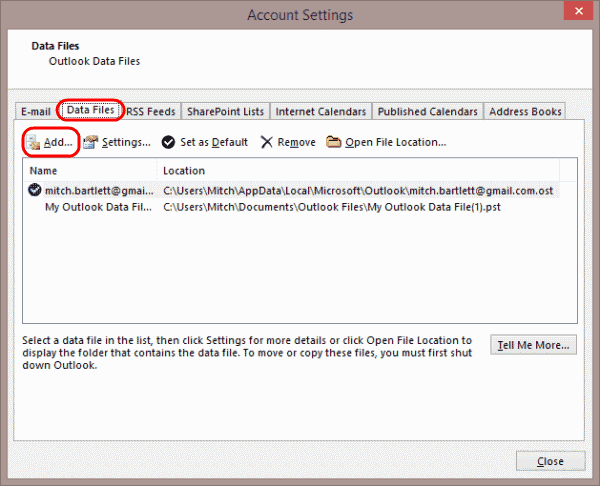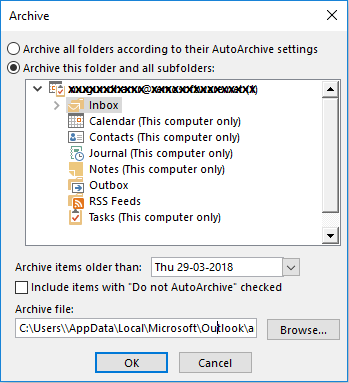
#Disable archive folder in outlook 2016 archive
Users can copy or move items from their primary mailbox to their archive mailbox, and can also use retention policies to move items to the archive using Outlook 2016, Outlook 2013, Outlook 2010, and Outlook on the web. In-Place Archiving in 2016 is similar to Exchange 2013 in-Place archiving, provides user with an alternate storage location for their messaging data.
#Disable archive folder in outlook 2016 license
NOTE: In-Place Archiving is a premium feature and it requires an Exchange Enterprise client access license (CAL). It appears along with the primary mailbox folders in Outlook or Outlook Web App, providing users a direct access to archived email and these archived items in the Personal Archive are available in Outlook and in Outlook Web App (OWA) on any computer that user access.

In-Place Archive is a special mailbox linked with a user’s primary mailbox. NOTE: In hybrid deployments of Exchange 2010 and later, can also provide a cloud-based archive for mailboxes located on on-premises Mailbox servers. pst files.Īdministrator can provide archive on the same mailbox database where the user’s primary mailbox located, another mailbox database on the same Mailbox server, or a mailbox database on another Mailbox server in the same Active Directory site. In-Place Archiving offers a consistent interpretation of messaging data to users and removes the requirement of. Users can view an archive mailbox and move or copy messages between their primary mailbox and the archive. Users can move or copy messages between their primary mailbox and the archive. Similar to exchange 2010, In-Place Archive is a supplementary mailbox (called an archive mailbox) allowed for a mailbox user and these mailboxes can be accessed by Microsoft Exchange Server 2010 or a later version, Microsoft Office Outlook and Outlook Web App. In-Place Archiving in Exchange server 2013 provides users with a storage location in which users can store their old messaging data. The personal archive is a supplementary mailbox (called an archive mailbox) enabled for a mailbox user and these mailboxes can be accessed by Microsoft Exchange Server 2010 or a later version, Microsoft Office Outlook and Outlook Web App and users can move or copy messages between their primary mailbox and the archive.Įxchange 2010 Service Pack 1 (SP1), allows to provide personal archive on the same mailbox database where the user’s primary mailbox is located, another mailbox database on the same Mailbox server, or a mailbox database on another Mailbox server in either the same or another Active Directory site. Personal archives ( on-premises archives) feature in Exchange server 2010 help an administrator to control the organization’s messaging data by removing the requirement of personal store (.pst) files and permitting users to store their messaging data in an archive mailbox on Exchange. Personal Archives (on-premises archives) in Exchange 2010: Messaging records management (MRM) management process (courtesy TechNet): Once a message reaches a retention limit, it will be archived/ deleted/ flagged for user attention/ the event is simply logged. Messages in managed folders are periodically managed by Exchange according to the folder content settings applied. The administrator / user places these managed folders in the user’s mailbox, and then the user categories individual messages or entire folders into the managed folders according to organization policy. Managed Folders are folders in the user’s mailbox on which managed content settings have been applied. Using Managed Folders, Messaging records management (MRM) provides an easier way to save messages which are required to fulfill company policy, government regulations, or legal needs. Messaging Records Management (MRM) in Exchange 2007: Messaging records management (MRM) is the record management technology which benefits the organizations in reducing the legal risks that are related to e-mail and other communications. With Exchange 2007, Microsoft has introduced Messaging Records Management (MRM), Exchange 2010 introduced Personal Archives, With Exchange 2013 In-Place Archiving and same has been continued in Exchange 2016.


Since Exchange Server 2007, Microsoft has been giving replacements for 3rd party archiving software. There are several 3rd party archiving solutions available in market for Exchange Server but in this article will discuss on Archiving solution available with Microsoft exchange. Sometimes Archive can be a sort of replacement for the backups. The archiving solution is very important in any modern organization in order to deal Storage management, Legal obligations, Performance issues, Operation expenses reduction and for User satisfaction.


 0 kommentar(er)
0 kommentar(er)
